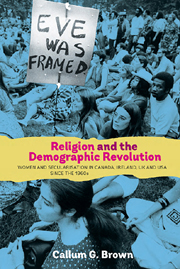 Religion and the Demographic Revolution
Religion and the Demographic Revolution Published online by Cambridge University Press: 05 April 2013
Introduction
The religious changes in Britain, Ireland, Canada and the United States between 1960 and 2010 have been very great. These changes have not been even, nor at the same pace, across this territory. Yet there have been many common features. The shifts within Christianity, the re-shaping of religious life and the nature of worship, the sharpening of the division between conservative and liberal, and the rise of new religious movements and spiritualities, have been most significant and, in many respects, unprecedented in scale and impact. But these have been overshadowed in magnitude by the decline in the social significance of religion. Depending on nation, this has ranged from the seismic to the marginal. The four nations under principal review present different and instructive experiences of this decline. But they also offer a lot in common. In this chapter, we examine the statistical evidence bearing on their religious transformation.
There is no perfection in statistics of religion. Indeed, they present some of the best examples for teaching students of the need for care with social-science data. The problems include: changing definitions, absence of agreed definition of ‘membership’ or ‘adherent’, absent (and changing inclusion over time of) categories, changing denominational practices, inaccuracy and imprecision in counting systems, reliance on partial enumerators (often clergy), and, for comparative study between countries, different national practices and traditions in counting ecclesiastical strength.
To save this book to your Kindle, first ensure [email protected] is added to your Approved Personal Document E-mail List under your Personal Document Settings on the Manage Your Content and Devices page of your Amazon account. Then enter the ‘name’ part of your Kindle email address below. Find out more about saving to your Kindle.
Note you can select to save to either the @free.kindle.com or @kindle.com variations. ‘@free.kindle.com’ emails are free but can only be saved to your device when it is connected to wi-fi. ‘@kindle.com’ emails can be delivered even when you are not connected to wi-fi, but note that service fees apply.
Find out more about the Kindle Personal Document Service.
To save content items to your account, please confirm that you agree to abide by our usage policies. If this is the first time you use this feature, you will be asked to authorise Cambridge Core to connect with your account. Find out more about saving content to Dropbox.
To save content items to your account, please confirm that you agree to abide by our usage policies. If this is the first time you use this feature, you will be asked to authorise Cambridge Core to connect with your account. Find out more about saving content to Google Drive.